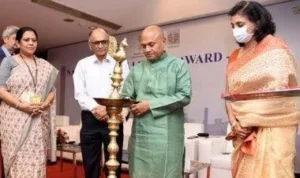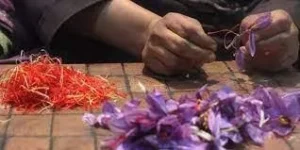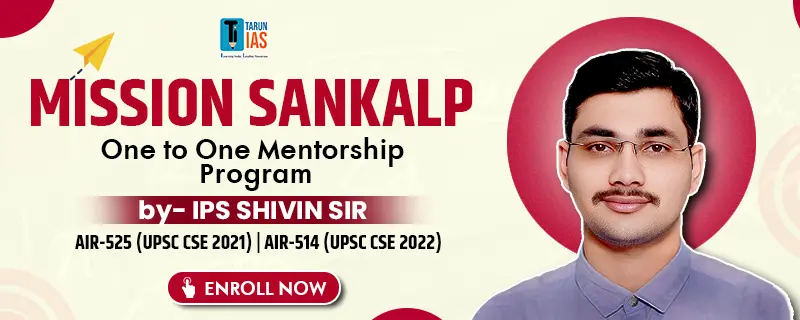UPSC GS 2
National Culture Fund
- News: Recently, the Ministry of Culture and Tourism highlighted the achievements of the National Mission for Manuscripts and the National Culture Fund.
- Establishment: Government of India had set up National Culture Fund (NCF) as a Trust on 28th November, 1996 under the Charitable Endowment Act, 1890.
- Purpose: To mobilize extra resources through Public-Private Partnerships (PPP) for promoting, protecting, and preserving India’s tangible and intangible cultural heritage.
- Objectives:
-
- Conservation and Maintenance: Administer and apply the Fund for the conservation, maintenance, promotion, protection, preservation, and upgrading of monuments, whether protected or otherwise.
- Training and Development: Provide training and facilitate the development of specialists and cultural administrators.
- Museum Development: Facilitate the creation of new museums and additional space in existing museums to accommodate or create new and special galleries.
- Documentation: Document cultural expressions and forms that are fading or facing extinction.
-

- Features:
-
- Governing Council: Chaired by the Minister of Culture, with a maximum of 25 members responsible for policy decisions.
- Executive Committee: Headed by the Secretary (Culture), with a maximum of 11 members, responsible for policy execution.
- Tax Benefits: Donations to the NCF are eligible for a 100% tax benefit under Section 80G (ii) of the Income Tax Act, 1961.
- CSR Eligibility: Activities covered under Schedule VII No. (v) of the Companies Act, 2013, which includes protection of national heritage, art, and culture, restoration of historical sites, and promotion of traditional arts.
- Audit: Annual accounts audited by the Comptroller and Auditor General of India.
-
- Role:
-
- Partnerships: The NCF forges partnerships with corporates, NGOs, and other entities to implement heritage preservation and conservation projects as per norms.
- Flexibility for Donors: Provides donors/sponsors the flexibility to indicate specific projects, locations, and implementing agencies.
- Project Monitoring: Regular meetings of the Project Implementation Committee (PIC) are held under the Chairmanship of the Director General, Archaeological Survey of India (ASI) for ASI projects and NCF/Ministry of Culture officials for other projects, to monitor progress and ensure smooth implementation.
- Donations: Receives donations from corporates, PSUs, trusts, and individuals for the maintenance and preservation of centrally protected monuments and cultural projects. Donors/sponsors must comply with the terms and conditions of the MoU for any particular project.
-
- National Mission for Manuscripts:
-
- The National Mission for Manuscripts was established in February 2003, by the Ministry of Tourism and Culture, Government of India.
- It is a National level comprehensive initiative which caters to the need of conserving manuscripts and disseminating knowledge contained in them.
- NMM is working towards fulfilling its motto, ‘conserving the past for the future’.
-
Read also: ENSO Dynamics: El Niño, La Nina, and Modoki Variations | UPSC
Right To Be Forgotten
- News: Recently, the Supreme Court agreed to hear a case whose outcome will likely shape the contours of the “right to be forgotten” in India.
- What Is The Right To Be Forgotten?
-
- ‘Right to be forgotten’ is also known as the ‘right to erasure’ in European information privacy regulation.
- The right to be forgotten can be described as the right to remove one’s digital footprint (from Internet searches, etc.) where it violates the right to privacy.
- It deals with individual rights to have a control of the use of their personal data, including photos, videos, etc and have it removed from the records of organisations.
-

- What Is The Status In India?
-
- In India, ‘right to be forgotten’ is considered as a part of the right to privacy, which is a fundamental right granted to Indian citizens under Article 21 of the Constitution.
- However, there are no specific clauses in the Indian laws governing ‘right to be forgotten’.
-
- Statutory Framework:
-
- In India, there is currently no specific statutory framework that prescribes the right to be forgotten.
- However, the right has been acknowledged in various legal contexts, including the Personal Data Protection Bill 2019 and various court rulings.
-
- The Personal Data Protection Bill 2019:
-
- The Personal Data Protection (PDP) Bill 2019 addresses the right to be forgotten by granting individuals the ability to restrict or prevent the continued disclosure of their personal data under the following conditions:
- Purpose Served: The data has served the purpose for which it was collected.
- Consent Withdrawal: The data was collected with the individual’s consent, which has since been withdrawn.
- Legal Non-compliance: The data was collected contrary to the PDP Bill or any prevailing law.
- The Personal Data Protection (PDP) Bill 2019 addresses the right to be forgotten by granting individuals the ability to restrict or prevent the continued disclosure of their personal data under the following conditions:
-
- Court Rulings:
-
- Supreme Court Ruling in K.S. Puttaswamy (2017): The Supreme Court of India recognized that the right to privacy includes the right to control one’s existence on the internet. This landmark judgment laid the groundwork for the right to be forgotten by emphasizing individual control over personal data.
-
- Delhi High Court Rulings:
-
- 2019: The Delhi High Court affirmed that the right to be forgotten and the right to be left alone are inherent aspects of the right to privacy.
- 2021: The court extended the right to be forgotten to criminal cases by allowing the removal of search results related to an American law student who was acquitted of narcotics charges.
- Orissa High Court Ruling (2020): The court acknowledged that the right to be forgotten involves complex practical and technological challenges, highlighting the need for extensive debate and clearer regulations.
-
- Conditions for Asserting the Right to be Forgotten: The Supreme Court of India clarified that an individual can assert the right to be forgotten if the personal data or information:
-
- No Longer Necessary: It is no longer necessary, relevant, or accurate and does not serve a legitimate interest.
- Limitations on the Right: This right cannot be asserted under certain conditions:
- Freedom of Expression: When necessary for exercising the right of freedom of expression.
- Legal Obligations: When required for compliance with legal obligations.
- Public Interest: When the information serves the public interest, such as in maintaining transparency in judicial records.
-
International Labour Organization (ILO)
- News: India, a founding member of the International Labour Organization (ILO), is likely to raise a complaint against the UN agency over its India Employment Report 2024.
- Purpose: The ILO is a specialized agency of the United Nations (UN) dedicated to improving labor conditions and living standards globally.
- Creation: The ILO was established in 1919 as part of the Treaty of Versailles, which ended World War I. It was founded on the belief that lasting peace can only be achieved through social justice.
- UN Affiliation: In 1946, the ILO became a specialized agency of the newly formed United Nations.
- Member States: The ILO has 187 member states, including 186 out of 193 UN member states and the Cook Islands.
- Tripartite Nature: The ILO is unique as the only tripartite UN agency, which brings together representatives from governments, employers, and workers of its 187 member states.

- Functions:
-
- International Policies and Programs: The ILO formulates policies and programs to promote basic human rights, improve working and living conditions, and enhance employment opportunities.
- International Labour Standards: It creates and supervises international labor standards through a unique system.
- Technical Cooperation: The ILO engages in extensive international technical cooperation, working in partnership with its constituents to help countries implement policies effectively.
- Training and Research: The organization conducts training, education, and research activities to support its efforts in improving labor conditions and standards.
-
- Recognition:
-
- Nobel Prize for Peace: In recognition of its work, the ILO was awarded the Nobel Peace Prize in 1969.
- Headquarters: The ILO’s headquarters are located in Geneva, Switzerland.
-
Defence Acquisition Council
- News: The Defence Acquisition Council (DAC) has approved capital acquisition proposals to enhance the capabilities of the Indian Army and the Indian Coast Guard.
- Definition: The Defence Acquisition Council is the highest decision-making body in the defence ministry for deciding on new policies and capital acquisitions for the three services and the Indian Coast Guard.
- Aim: To ensure expeditious procurement of the approved requirements of the armed forces.
- Composition:
-
- Chairman: The defence minister is the chairman of DAC.
- Members: Its members include the Chief of Defence Staff (CDS) and chiefs of the Army, Navy, and Air Force.
-
- Functions:
-
- Accord of acceptance of necessity to acquisition proposals.
- Categorization of the acquisition proposals relating to ‘Buy’, ‘Buy & Make’, and ‘Make’.
- Look into issues relating to single vendor clearance.
- Take decisions regarding ‘offset’ provisions in respect of acquisition proposals above Rs 300 crore.
- Take decisions regarding the Transfer of Technology under the ‘Buy & Make’ category of acquisition proposals.
- Field trial evaluation.
-
UPSC GS 3
Saffron Crop
- News: Faced with declining production, many saffron farmers in Kashmir are converting their fields into apple orchards or growing mustard.
- Cost and Popularity: Saffron is one of the costliest herbal spices globally and is commonly referred to as “Red Gold” or the “Golden Condiment.”
- Commercial Part: The commercial part of saffron is the stigma, which is the female part of the flower. It is also known as saffron filament, saffron thread, or saffron stigmata.
- Seeds and Regeneration: The seeds of saffron are called corms or bulbs. The saffron plant regenerates through the vegetative multiplication of these underground corms.
- Key Constituents: Saffron contains crocin, picrocrocin, and saffranal, which are important for both medicinal and aesthetic purposes.
- Distribution
-
- Native Regions: The saffron plant is native to Greece and Asia Minor.
- Current Cultivation: It is now cultivated in various parts of Europe, including Italy, France, and Spain, as well as in China and India.
- Indian Production: In India, approximately 90% of saffron production comes from Kashmir, where it has been cultivated for centuries.
-

- Required Climatic Conditions
-
- Elevation: Saffron grows best at elevations of 1,500 to 2,000 meters above mean sea level.
- Temperature: It requires specific climatic conditions with summer temperatures not exceeding 35°C to 40°C and winter temperatures ranging from about -15°C to -20°C.
- Climate Types: Saffron can be grown in dry, moderate, and continental climate types.
-
- Soil Requirements
-
- Soil Types: Saffron thrives on loamy, sandy, and calcareous soils.
- Soil pH: It grows best in acidic soil with a pH range of 5.5 to 8.5.
-
Oropouche Fever
- News: Brazil’s health ministry has confirmed the first-ever deaths due to Oropouche fever, a virus similar to severe dengue.
- Overview of Oropouche Fever:
-
- Disease Description: Oropouche fever is an emerging zoonotic arboviral disease caused by the Oropouche Virus (OROV).
- Discovery: It was first identified in Trinidad and Tobago in 1955.
-
- Transmission:
-
- Primary Vector: The disease is transmitted to humans through the bite of an infected midge, particularly the Culicoides paraensis midge, or mosquito.
- Contributing Factors: Urbanization, deforestation, and climate change contribute to the proliferation of the disease’s vectors, increasing the risk of transmission.
- Human-to-Human Transmission: There is currently no evidence of human-to-human transmission of Oropouche fever.
-

- Symptoms:
-
- Onset and Duration: Symptoms typically begin between four and eight days after being bitten.
- Common Symptoms: The onset is sudden and symptoms usually include fever, headaches, pain, chills, joint stiffness, and occasionally nausea and vomiting.
-
- Treatment:
-
- Vaccines and Specific Treatment: There are no vaccines or specific treatments available for Oropouche fever.
- Medical Care: Treatment focuses on controlling symptoms and aiding recovery.
-
Butterflies
- News: Scientists are racing to save South Asia’s butterflies from the threat of extinction.
- Major Butterfly species found in India: Kaiser-i-Hind, Malabar Tree-Nymph, Blue Pansy, Malabar Banded Peacock, Blue Mormon, Blue Duke, Tamil Yeoman, Common Birdwing, Common Peacock, Common Crow, Pioneer White, Dark Blue Tigers, Double-branded Crows, and Lime Swallowtail.

- Facts about Butterflies:
-
- Butterflies, along with the moths and the skippers, make up the insect order Lepidoptera.
- Most adult butterflies live only one or two weeks, but some species hibernate during the winter and may live several months.
- A group of butterflies is sometimes called a flutter.
- Their eyes are made of 6,000 lenses and can see ultraviolet light.
- Many adult butterflies never excrete waste – they use up all they eat for energy.
- Butterflies are essentially cold-blooded.
-
Mekedatu Reservoir Project
- News: The Chief Minister of Karnataka recently stated that his government is open to discussions with Tamil Nadu regarding the implementation of the Mekedatu project across the Cauvery River.
- Purpose:
-
- The Mekedatu Project is a multi-purpose initiative proposed by Karnataka, aimed at providing both drinking water and power.
- It involves constructing a balancing reservoir near Kanakapura in the Ramanagara district of Karnataka.
-
- Location:
-
- The project site is approximately 90 kilometers from Bengaluru and 4 kilometers from the border with Tamil Nadu.
- It is situated at the confluence of the Cauvery River and its tributary, the Arkavathi River.
-

- Construction Details:
-
- The plan includes building a concrete gravity dam that will be 99 meters high and 735 meters long.
- An underground powerhouse and a water conductor system are also part of the project.
- The expected capacity of the dam is 66,000 TMC (thousand million cubic feet) of water.
- Once completed, the project is expected to supply over 4 TMC of water to Bengaluru for drinking purposes.
- The estimated cost of the project is around Rs 14,000 crores, and it will cover an area of over 5,000 hectares.
-
- Issues and Concerns:
-
- Tamil Nadu’s Position: Tamil Nadu, as the lower riparian state, has expressed concerns about the project. The state argues that the Mekedatu Project threatens its water requirements.
- Tamil Nadu contends that the Mekedatu area represents the last point in Karnataka where Cauvery water flows unrestricted into Tamil Nadu. The state views the Mekedatu dam project as an attempt by Karnataka to restrict this free flow of water.
- According to the Cauvery Water Disputes Tribunal and the Supreme Court order, Tamil Nadu must give its no-objection for any project proposed on the Cauvery River.
-
National Metallurgists Day Awards
- News: Ministry of Steel has invited applications for National Metallurgist Awards -2024.
- Establishment:
-
- The National Metallurgist Awards were instituted in 1962 by the Ministry of Steel & Mines.
-
- Aim:
-
- To recognize and honor outstanding contributions in the field of metallurgy.
- This includes contributions across various areas such as operations, research, design, education, waste management, and energy conservation.
-
- History: The first National Metallurgist Award was given in 1963, and the awards have been presented annually since then.
- Frequency: The awards are presented annually.
- Purpose: These awards aim to acknowledge exceptional achievements in metallurgy, covering the following areas:
-
- Operations
- Research & Development
- Waste Management
- Energy Conservation
-
- Nominations:
-
- Nominations are invited online through the Ministry of Steel’s Portal or the centralized portal being developed by the Ministry of Home Affairs.
- Nominations can be submitted by companies, organizations, or individuals through self-nomination.
-
- Eligibility: The awards are given exclusively to Indian nationals.
- Categories: The awards are presented in the following four categories:
-
- Lifetime Achievement Award
- National Metallurgist Award
- Young Metallurgist Award (Environment and Metal Science)
- Award for R&D in Iron & Steel Sector
-
See this: Best IAS Coaching In Shillong
ISTIC-UNESCO
- News: The first-ever STI Conclave on “Traditional Knowledge for Sustainable Livelihoods” by the International Science, Technology, and Innovation Centre for South-South Cooperation (ISTIC) in collaboration with the Council of Scientific and Industrial Research (CSIR) is being held from July 29 to 31 in New Delhi.

- Definition:
-
- The International Science, Technology and Innovation Centre for South-South Cooperation under the Auspices of UNESCO (ISTIC) is a UNESCO Category 2 Centre.
-
- Aim:
-
- The Centre acts as an international platform offering sustainable programmes and services and augmenting sustainable development for South-South Cooperation.
- The Malaysian Government has hosted ISTIC since 2008.
-
- Hosting Agreement:
-
- The Centre’s hosting is governed by a six-year Agreement between the Malaysian Government, represented by the Ministry of Science, Technology and Innovation (MOSTI), and UNESCO.kkk
- The current Agreement is in effect from February 2022 to January 2028.
-
- Mission:
-
- ISTIC’s mission is to be “a leading international platform offering sustainable programmes and services in producing holistic talents towards institutional excellence and augmenting sustainable development for South-South Cooperation.”
- The Centre supports the exchange of students, researchers, scientists, and technologists among developing countries.
-
- UNESCO Category 2 Centre:
-
- UNESCO Category 2 Centres are a global network of institutions of excellence in UNESCO’s domains of competence.
- These centres are privileged partners of UNESCO and have access to UNESCO’s logo, international and intergovernmental bodies, and networks.
- They can leverage UNESCO’s international reach and convening power.
- Category 2 institutes and centres are an integral part of UNESCO’s Comprehensive Partnership Strategy, contributing to the organization’s goals and initiatives.
-

